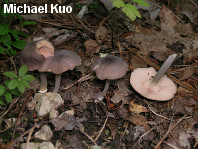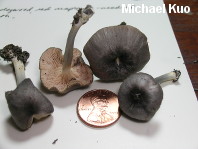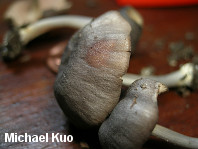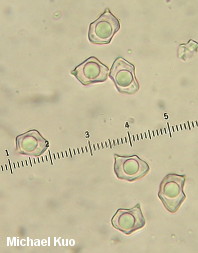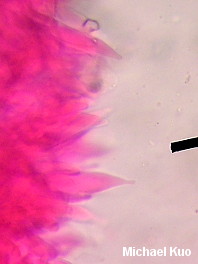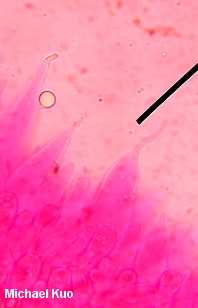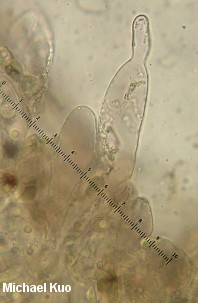| Major Groups > Gilled Mushrooms > Pink-Spored > Entolomatoid Mushrooms > Entoloma species 01 |

|
Entoloma species 01 [Basidiomycota > Agaricales > Entolomataceae > Entoloma . . . ] by Michael Kuo I collected this little entolomatoid mushroom in Kentucky. To the naked eye it looks like a slew of other small, grayish to bluish or purplish members of subgenus Leptonia . . . but under the microscope, it really stands out. "Cheilocystidia" (special sterile cells on the edges of the gills) in Entoloma often deserve quotation marks, since they are frequently unimpressive and difficult to distinguish from other structures. But in some species there are impressive, honest-to-God cheilocystidia like those in the illustrations to the right. My collection comes very close to, and may well represent, Entoloma subcorvinum, described by Hesler (1967) on the basis of a collection from Great Smoky Mountains National Park; see the discussion below. Description: Ecology: Saprobic; growing gregariously along a path under eastern hemlock, dogwood, red maple, and Virginia pine; August; Wolfe County, Kentucky. Cap: 17-30 mm across; convex; shallowly umbilicate; dry; silky or, over the center, finely scaly; dark gray with a faint hint of purple; darker over the center. Gills: Just beginning to run down the stem; close; white becoming pink; short-gills frequent. Stem: 3-5 cm high; 2-4 mm thick; more or less equal; bald; dull gray; basal mycelium white. Flesh: Thin; white. Chemical Reactions: KOH pink on cap surface. Odor and Taste: Odor slightly foul or spermatic. Spore Print: Pink. Microscopic Features: Spores 8-9 x 5-6 µ; heterodiametric; 5- or 6-sided; smooth; hyaline. Pleurocystidia not found. Cheilocystidia abundant; fusiform to lageniform; 50-75 x 5-15 µ; thin-walled; apices often quite sharp. Pileipellis a cutis with occasional areas of inflated, trichodermial-cystidioid elements; pigment brown, intracellular. Clamp connections not found. REFERENCES: (Hesler, 1967; Largent, 1977; Noordeloos, 1988; Largent, 1994; Hesler, 2013) Herb. Kuo 08111202. While Hesler's original description of microscopic characters for Entoloma subcorvinum was very minimal, type studies by Largent (1977) and Noordeloos (1988) were much more thorough. Further collections of Entoloma subcorvinum, beyond the type collection, do not appear in the nation's major herbaria (as represented by a search of MyCoPortal). My collection differs somewhat from Hesler's description of Entoloma subcorvinum in its colors; Hesler calls the cap "blue-black to near 'hair brown,'" with a "black-scaly" center, while the stem is "'light neutral gray' (gray-blue)." Another possible macroscopic difference is the cap margin, which Hesler calls "striate." However, I have examined the black-and-white photo of the type collection in the fresh state, and the margins of the specimens depicted are only slightly lined, and only so in larger caps. Microscopically, my collection's spores are slightly shorter and skinnier than those of Entoloma corvinum, which measure 8-11.5 x 6-8 µ according to Hesler (1967), 9-10 x 6.7 µ according to Largent (1977; the "6.7" is presumably a typo for 6-7, especially since Largent then says the average spore width is 6.9 µ), and 8-11 x 6.3-7 µ according to Noordeloos (1988). Additionally, Noordeloos recorded the pileipellis pigment as "blue" in the type collection. This site contains no information about the edibility or toxicity of mushrooms. |
© MushroomExpert.Com |
|
Cite this page as: Kuo, M. (2014, February). Entoloma species 01. Retrieved from the MushroomExpert.Com Web site: http://www.mushroomexpert.com/entoloma_sp_01.html |
